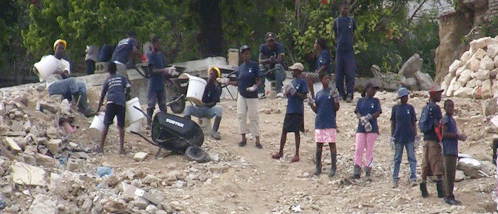What is cash-for-work?
“Cash-for-work” (CFW) is a term used by humanitarian agencies to mean short-term jobs meant for unskilled labor. A main objective is to get money circulating in order to “relaunch” an economy. Workers are paid minimum wage or less. The term appears to come from a related program, “Food for Work” (FFW), which humanitarian agencies have been using in Haiti and around the world for decades.
Cash has replaced food. As a recent issue of Humanitarian Exchange Magazine explained: “Cash has rapidly become an effective part of the humanitarian toolbox.”
In Haiti, CFW programs are aimed at earthquake victims who live in the 1,300 camps for displaced people or in the countryside with friends or family.
A CFW job is typically eight hours a day, five or six days a week, two or four weeks in length, with a daily salary of 200 gourdes (Haiti’s minimum wage, about US$5.00). Typical jobs include: street-sweeping, cleaning drainage canals, rubble removal by hand, building latrines in camps, clearing or repairing rural dirt roads using picks and shovels, and digging contour canals on hillsides.

Some CFW jobs are actually CFW and FFW, because rather than receiving 200 gourdes, the worker gets 120 gourdes (US$4.00) and a food ration. In some parts of the country, workers get food only, like near Maniche in the south, where workers get a sack of wheat, a sack of beans and five gallons of oil after four weeks of work.
Unfortunately for the Haitian government, for economists and for the public at large, no one person or agency actually knows how many people are working in the multitude of CFW and FFW programs in Haiti at the moment.
Haiti Grassroots Watch spoke with CFW workers and supervisors, with representatives of various humanitarian agencies, and also scanned dozens of documents and websites. While many people were able to report that their program had 1,500 jobs or 2,500 jobs on any one day, nobody has totaled up the jobs, mapped their locations, or tallied up that the workers are doing. (The lack of coordination in this sector is similar to what Haiti Grassroots Watch found in Dossier #1 earlier this fall, related to resettling the 1.3 million homeless.)
For example: Concern Worldwide reports 400 workers; American Refugee Committee, 105; Catholic Relief Services, 6,000; Mercy Corps employs about 600 near Hinche, the World Food Program (WFP) said it will have employed a total of 140,000 people by the end of 2010, but the length of employment varies. The United Nations Development Program claims it will have employed almost 400,000 people by the end of 2010 (although the WFP says that some of those jobs are counted as WFP jobs, too). The cost of the UNDP program? About US$80 million.
Origins and objectives
While the term “cash-for-work” is a relatively recent addition to humanitarian literature, the concept has been around for a long time.
In fact, British Economist John Maynard Keynes (1883-1946) might be considered the father of “cash-for-work.”
Oxford University Press summarized Keynesian thought on state intervention this way:
Stated simply, Keynes blamed the [1929 Wall Street] crisis on insufficient demand, caused by 'orthodox' economic thinking about the virtues of the free market. Keynes argued for a much more intrusive and creative role for the state, which should adjust demand within the economy in order to ensure (relative) stability across economic cycles which otherwise would be a series of 'booms' and 'busts'.
One of Keynes's key insights was the tendency for increased demand to have a 'multiplying' effect, so that government intervention (say) in job-creation would promote new opportunities for work in industries which depended upon consumer spending.
During the Great Depression n the U.S., the Franklin D. Roosevelt administration put Keynes’ theory to work. Two New Deal jobs programs – the Civilian Conservation Corps and the Work Projects Administration (WPA) – employed millions at a time.

WPA roadworkers and a WPA artist sketching the workers.
But as Truthdig’s Robert Scheer recently wrote in his new book, The Great American Stickup: How Reagan Republicans and Clinton Democrats Enriched Wall Street While Mugging Main Street, capitalism is haunted by more than depressions and recessions.
“The great and terrible irony of capitalism is that if left unfettered, it inexorably engineers its own demise, through either revolution or economic collapse…
Government regulation of the market economy arose during the New Deal out of a desire to save capitalism rather than destroy it.”
FDR’s New Deal offers a perfect example. With thousands of jobless men and women marching on Washington, and with labor organizations and socialist or communist parties gaining strength, the jobs programs were as much about preventing revolution as they were about jump-starting the economy.
CFW predecessors in Haiti
Those two goals have also been behind the various jobs programs in Haiti across the years.
François “Papa Doc” Duvalier had a program of “woy-woy” or temporary “make-work” jobs which were administered through his Public Works ministry. Duvalier used woy-woy jobs – and terror – to prevent any kind of uprising.
But long before Duvalier’s woy-woy jobs, the US began what has turned out to be a series of radical interventions into the Haitian economy as it tried to prevent revolution along with migration to the US, as well as install capitalist structures and practices that would benefit the US economy.
The first big interventions took place during the US occupation (1915-1934). By its end, over a dozen agro-industries – rubber, sugar and pineapple businesses – had taken hundreds of thousands of acres of land, many of it formerly farmed by peasants.
These newly landless peasants offered cheap labor – 10 to 30 US cents a day – for the plantations and agro-industries. The US State Department justified the “adjustment” of Haiti’s economy with now-familiar promises, saying it would “give the population work and assure economic development,” according to historian Suzy Castor.
Also during this period, the US government encouraged projects it said would “modernize” the agricultural sector, but, according to Castor, “the occupation did not solve or even improve the Haitian agricultural crisis.”
After the occupation, the US government’s Ex-Im Bank backed mostly US investors who set up businesses that included a New Deal-like promise of employing thousands and stimulating consumption.
The programs and projects did produce many results: the Peligre dam which displaced and impoverished thousands of peasant families, inflation, corruption, profits for the foreign companies (including US military subcontractor KBR, then called Brown and Root), and an additional US$33 million debt for the Haitian government, according to economist Gérard-Pierre Charles.

Missing from the list of results, however, were the promised improvements to the economy via increased demand and supply.
Washington’s next big interventions came during the Duvalier regimes. The US pumped in millions, at first to support the dictatorship as a bulwark against communism, and then for agricultural “development” projects aimed at staunching the flow of US-bound “boat people” refugees.
But the flow did not stop. So, in 1982, “the USAID and multi-lateral development agencies, including the World Bank, the International Monetary Fund, and the Inter-American Development Bank, formulated a new strategy,” which was “unprecedented in both its scope and its size,” according to migration specialists Josh DeWind and David H. Kinley III.
The strategy included attempting to “increase Haiti’s integration into the international economy and particularly into U.S. markets” with projects mostly run by “private and voluntary organizations (PVOs)… in order to bypass generally ineffective host-country government agencies.”
PVOs are the predecessors to today’s “non-governmental organizations” or NGOs[1] – the “Republic of NGOs” was born.
In 1988, DeWind and Kinley noted that “the new strategy seems to have maintained and even exacerbated the economic and political problems that have caused Haitian emigration” but USAID, the World Bank and the PVO/NGO subcontractors, have continued along the same path.
More recently, USAID programs have included massive jobs programs for the now millions of destitute peasants and former peasants. But numerous studies, like Feeding Dependency, Starving Democracy: USAID Policies in Haiti and Democracy Undermined, Economic Justice Denied, both produced in 1997, show that the programs have done little good.
Feeding Dependency looked at USAID-formulated FFW jobs programs that are not dissimilar with today’s CFW programs, except that workers were often paid with US food, not cash. The report concluded that USAID programs “further[ed] US economic interests, not Haitian development.”
The report looked at a program of “labor-intensive, jobs-creation programs” established in 1993, when Washington realized that the return of then exiled-President Jean-Bertrand Aristide to Haiti was inevitable. USAID created the $18 million dollar program in order to “increase the income of many poor Haitian families” and “create a sense of confidence and hope.” Focusing on rehabilitation and improvement of agricultural land, the program was bumped up to a total of $38 million, running for 34 months, and reportedly employed 50,000 workers a day at its peak.
But was the objective really to “create a sense of confidence and hope”?
Or was it also to perhaps assure that the supporters of Aristide and of the progressive democratic and popular movement with its left-leaning demands did not find terrain to mobilize once Constitutional order was restored in 1994?
Feeding Dependency discovered that the USAID jobs programs “actively strengthened anti-democratic forces and weakened grassroots, democratic organizations,” noting that:
The negative implications that this carries for sustainable, community-based development cannot be overemphasized. By conducting the program under the coup regime, the US was providing the illegal government with political support.
The report also said the programs:
• pulled peasants away from food production,
• created new, “unsustainable” habits of consumption,
• hindered “the volunteerism and community spirit necessary for development,” and
• “generate[d] dependency.”
Finally, the study noted that much of the infrastructure work was ephemeral – canals quickly filled in and hand-built roads reverted to rocky paths during the subsequent rainy season.
See Part 2 – Is Cash-for-Work working? – to learn about the programs being implemented in Haiti today
Return to the Introduction, and the video
Footnotes and References:
1. The term “non-governmental organization” is a misnomer in many cases, since these organizations often receive large contracts directly from foreign governments. However, since the term “NGO” is used by CFW workers, HGW will use it in this case.
Suzy Castor, L’Occupation américaine d’Haïti, 1988 edition.
Gérard Pierre-Charles, L’Économie Haïtienne et sa voie de Développement, 1967.
Josh DeWind and David H. Kinley III, AIDING MIGRATION – The Impact of International Development Assistance on Haiti, 1988.

